
Tapestry is a form of textile art, traditionally woven by hand on a loom. Normally it is used to create images rather than patterns. Tapestry is relatively fragile, and difficult to make, so most historical pieces are intended to hang vertically on a wall, or sometimes horizontally over a piece of furniture such as a table or bed. Some periods made smaller pieces, often long and narrow and used as borders for other textiles. Most weavers use a natural warp thread, such as wool, linen, or cotton. The weft threads are usually wool or cotton but may include silk, gold, silver, or other alternatives.

The Raphael Cartoons are seven large cartoons for tapestries, surviving from a set of ten cartoons, designed by the High Renaissance painter Raphael in 1515–16, commissioned by Pope Leo X for the Sistine Chapel in the Vatican Palace. The tapestries show scenes from the Gospels and Acts of the Apostles and are hung below the frescoes of the Life of Christ and the Life of Moses commissioned by Pope Sextus. The cartoons belong to the British Royal Collection but since 1865 are on loan to the Victoria and Albert Museum in London.

Bernard van Orley, also called Barend or Barent van Orley, Bernaert van Orley or Barend van Brussel, was a versatile Flemish artist and representative of Dutch and Flemish Renaissance painting, who was equally active as a designer of tapestries and, at the end of his life, stained glass. Although he never visited Italy, he belongs to the group of Italianizing Flemish painters called the Romanists, who were influenced by Italian Renaissance painting, in his case especially by Raphael.
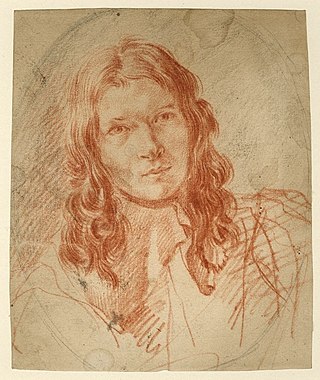
Philips Wouwerman was a Dutch painter of hunting, landscape and battle scenes.

The Gemäldegalerie is an art museum in Berlin, Germany, and the museum where the main selection of paintings belonging to the Berlin State Museums is displayed. It was first opened in 1830, and the current building was completed in 1998. It is located in the Kulturforum museum district west of Potsdamer Platz.

The Residenz in central Munich is the former royal palace of the Wittelsbach monarchs of Bavaria. The Residenz is the largest city palace in Germany and is today open to visitors for its architecture, room decorations, and displays from the former royal collections.
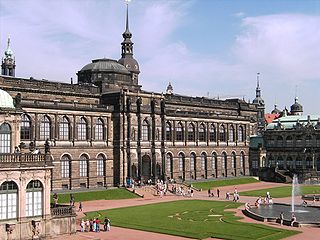
The Gemäldegalerie Alte Meister in Dresden, Germany, displays around 750 paintings from the 15th to the 18th centuries. It includes major Italian Renaissance works as well as Dutch and Flemish paintings. Outstanding works by German, French, and Spanish painters of the period are also among the gallery's attractions.

Staatliche Kunstsammlungen Dresden is a cultural institution in Dresden, Germany, owned by the State of Saxony. It is one of the most renowned and oldest museum institutions in the world, originating from the collections of the Saxon electors in the 16th century.

The Primate's Palace is a neoclassical palace in the Old Town of Bratislava the capital of Slovakia. It was built from 1778 to 1781 for Archbishop József Batthyány, after the design of architect Melchior Hefele. In 1805, the Palace's Hall of Mirrors saw the signing of the fourth Peace of Pressburg, ending the War of the Third Coalition. Today, it serves as the seat of Mayor of Bratislava.
Stoke Park Pavilions are all that remain of the stately house and grounds of Stoke Park near the village of Stoke Bruerne, Northamptonshire, England, approximately 8 miles (13 km) south of Northampton and 11 miles (18 km) north of Milton Keynes.
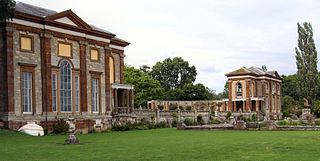
Sir Francis Crane was the founder of Mortlake Tapestry Works at Mortlake on the south bank of the river Thames in South West London.
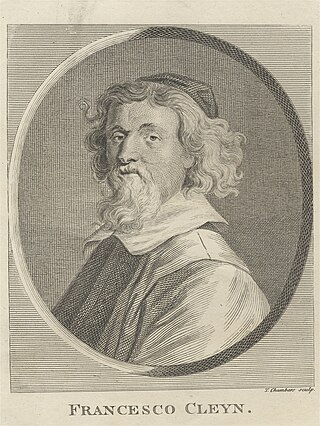
Francis Cleyn was a German-born painter and tapestry designer who lived and worked in England.
Josias English was an amateur etcher. He was originally thought to have died in 1718, but upon the discovery of his will it transpired his death actually occurred in 1705.
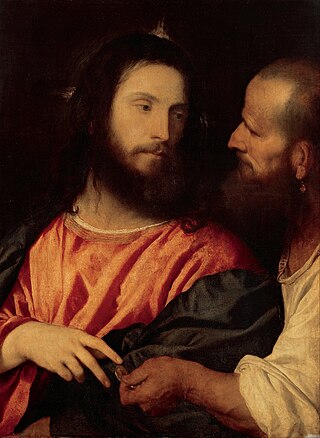
The Tribute Money is a panel painting in oils of 1516 by the Italian late Renaissance artist Titian, now in the Gemäldegalerie Alte Meister in Dresden, Germany. It depicts Christ and a Pharisee at the moment in the Gospels when Christ is shown a coin and says "Render unto Caesar the things that are Caesar's, and unto God the things that are God's". It is signed "Ticianus F.[ecit]", painted on the trim of the left side of the Pharisee's collar.

Brussels tapestry workshops produced tapestry from at least the 15th century, but the city's early production in the Late Gothic International style was eclipsed by the more prominent tapestry-weaving workshops based in Arras and Tournai. In 1477 Brussels, capital of the duchy of Brabant, was inherited by the house of Habsburg; and in the same year Arras, the prominent center of tapestry-weaving in the Low Countries, was sacked and its tapestry manufacture never recovered, and Tournai and Brussels seem to have increased in importance.
Penelope Cleyn was a miniature painter active in London. Her exact birth and death dates are not known.
The Story of Abraham is a set of ten Brussels tapestries depicting stories from the life of the biblical prophet Abraham. They appear to have been designed by Bernaert van Orley initially, but completed by Pieter Coecke van Aelst around 1537, both artists who were leading designers for the Brussels workshops. Three sets survive.
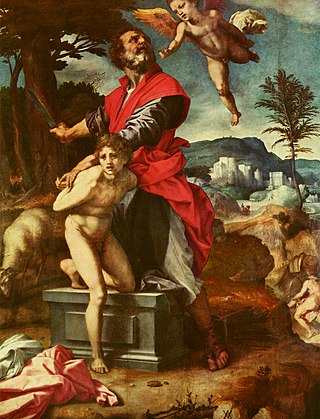
Sacrifice of Isaac is a work by the Italian Renaissance painter Andrea del Sarto, existing in three versions at the Gemäldegalerie Alte Meister in Dresden, the Cleveland Museum of Art and the Museo del Prado.

Madonna and Child with Saints is a 1588 oil on canvas painting by Annibale Carracci, now in the Gemäldegalerie Alte Meister in Dresden. Signed and dated by the artist, it is also known as Madonna and Child with Saints Francis, Matthew and John the Baptist, Madonna and Child Enthroned with Saint Matthew and the St Matthew Madonna.
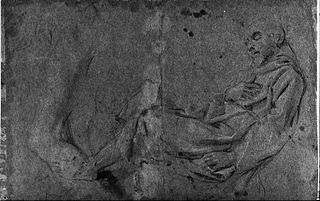
The Death of Saint Francis is the probable subject of two lost paintings by Annibale Carracci, both possibly dating to 1597-1598. One is known solely through a print and the other through a series of painted copies.






















